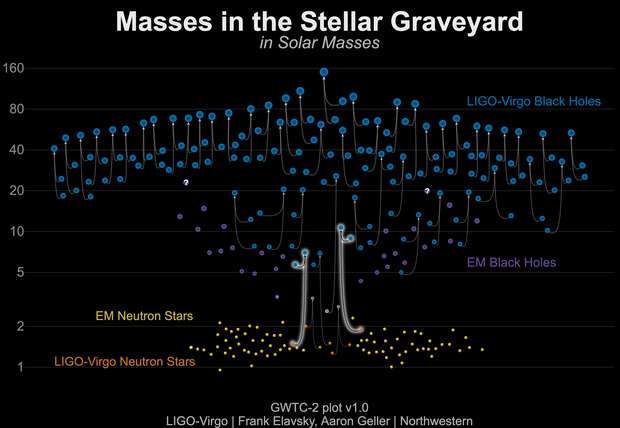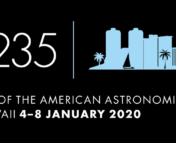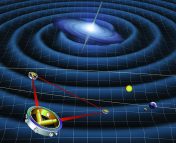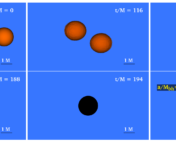Title: Observation of Gravitational Waves from Two Neutron Star–Black Hole Coalescences
Authors: LIGO-Virgo-KAGRA Collaboration
Status: Published in the Astrophysical Journal Letters [open access]
If a neutron star and black hole merge in a distant galaxy and no one is around to hear it, does it make a sound? This type of merger between two different compact objects has been predicted to exist, but never observed — until now! On June 29, 2021 the LIGO/Virgo/KAGRA Collaboration announced their discovery of TWO neutron star black hole (NSBH) binary mergers, both detected just 10 days apart in January 2020.
LIGO, the Laser Interferometer Gravitational-wave Observatory, and its counterparts outside of the US, are revolutionary detectors that have essentially opened up a new sense to study the Universe. Traditional observatories work by “seeing” the light waves emitted from astrophysical objects using electromagnetic sensors like telescopes. On the other hand, observatories like LIGO “hear” gravitational waves emitted from dense objects colliding, which sends ripples through the fabric of spacetime, stretching and compressing the space between perpendicular laser arms. (Learn more about how this works in this Astrobite!)
LIGO is sensitive to a few different types of events that emit gravitational waves. In the previous sets of observing runs, LIGO has detected signals from compact object mergers that are more like twins, either two black holes or two neutron stars. Both types of compact objects are the remnants of stars, and what remnant type the star becomes depends on the original star’s mass. Moderately massive stars evolve into dense neutron stars, which is analogous to shoving the mass of the Sun into a small-city-sized sphere. The most massive stars of all push past this limit and become black holes, which are so “dense” the concept of density doesn’t really apply.
A new member of the stellar graveyard
So far, previous observations of compact remnants have been limited to singletons and twins, with a number of binary black holes (BBH) and a few binary neutron stars (BNS) detected via gravitational waves. NSBHs have been an elusive system for any form of observation as they are likely rare systems, but there’s no reason a neutron star and a black hole couldn’t pair up and merge. Modeling work to synthesize populations of stars have predicted the existence of NSBHs, with a pretty wide range in the predicted merger rates. Now, LIGO has introduced two pairs of siblings (or cousins?): two NSBH mergers. These are the first of their kind confidently observed with any method! See the simulation below for a visualization of a NSBH merger.
Introducing GW200105 and GW200115
The LIGO Collaboration announced observations of these two NSBH events, called GW200105 and GW200115 after their date of detection. Both are classified as NSBHs based on the masses of each object in the merger. By carefully extracting the signal from the noise and running various parameter estimation techniques, the team measured key properties of the pairs of objects. Check out the summary fact sheet from LIGO here, and see how they fit into the “stellar graveyard”–a popular diagram cataloging compact object discoveries–in Figure 2.

GW200105 has a primary mass of 8.9 solar masses (consistent with a black hole), and a secondary mass of 1.9 solar masses (consistent with a neutron star). LIGO Livingston heard the signal loud and clear, with a lower signal received by Virgo. LIGO Hanford was not operating at the time, essentially making this a single-detector event. GW200115 has a primary mass of 5.7 solar masses (black hole), and a secondary mass of 1.5 solar masses (neutron star). This was a multi-detector event, with signals received by LIGO Livingston and Hanford as well as Virgo. Figure 3 shows the gravitational wave signals from each event.

What’s (and where’s) the matter?
In the case of BBHs, there is no matter to emit light, and for BNSs, a cataclysmic explosion can be seen if we’re lucky and point a telescope at the right spot. Do we expect to see an explosion from a NSBH? Maybe–check out this Astrobite for more on electromagnetic signatures from NSBH mergers–but for these two NSBH mergers, no electromagnetic signal was detected. Still, it’s not surprising we didn’t catch it, for two main reasons. First, the mergers took place in a pretty distant galaxy, so any signal was likely too weak. Second, gravitational-wave detectors (especially with strong signal from only one detector as was the case for GW200105) aren’t perfect at figuring out where in the sky the signal came from, so the area on the sky was too large to search effectively even with a global network of telescopes in action.
One thing the authors note is that with the lack of electromagnetic detections, the secondary objects are classified as neutron stars solely because their masses are consistent with predicted and observed neutron star masses. To be absolutely certain these were NSBHs rather than BBHs, we would need to see evidence of some matter. Still, comparisons to stellar population modeling supports the conclusion that these systems are NSBHs.
Siblings or cousins?
With one minute or less of data to work with in each case, the team compared the data to astrophysical models to test predictions for how NSBHs form. Various formation channels have been proposed, with the main channels either isolated binary evolution or some sort of dynamical capture. Isolated binary evolution is sort of like siblings, where the original stars are born and evolve together, orbiting around each other long enough to consume their fuel and become stellar remnants, which eventually merge. The dynamical channel is more like cousins, where the stars form within a cluster environment, and while they evolve into stellar remnants one captures the other with its gravitational influence, forming an orbiting pair of compact objects that eventually merge.
It’s likely that NSBHs in general form via various formation channels, rather than any single method. In this case, though, the black hole masses are found to be consistent with what’s expected from models of isolated binary evolution, suggesting the two pairs are siblings. But comparing how the objects are spinning with respect to each other provides more clues. Interestingly, the primary object of GW200115 had a spin opposite of the secondary object. This hints at dynamical capture since these binary cousins tend to have random spin orientations while isolated sibling binaries are usually well aligned.
How rare are these NSBH mergers?
With confident observational evidence for NSBHs, the team was able to directly measure the merger rate of NSBHs in the local Universe for the first time. They use two methods of estimation, one considering these two events to be representative of the whole population, and another constructing a broader population and allowing for less significant events that could’ve gone undetected. This produced a range of merger rate estimates, generally supporting the conclusions that NSBHs are rarer than BNSs, and much rarer than BBHs — for every 10 or so BNSs, we can expect 1 NSBH. To put it another way, we expect 5-15 NSBH systems to merge per year within a distance of 1 billion light years. This result is broadly consistent with the fact that no NSBHs have been detected previously.
So what did we learn from these events? Based on what we know about the masses of neutron stars and black holes, these seem like NSBHs. Since there were no electromagnetic counterparts, we can’t fully confirm the presence of neutron stars, although this lack of detection is expected due to the properties of the objects and the large distance to the mergers. These first direct measurements of NSBHs and their merger rates allow us to test theoretical predictions of how these objects form. And there’s plenty more to learn from these detections and future detections of NSBHs, including precise measurements of the Hubble constant (see this Astrobite), especially with plans to build more sensitive gravitational wave detectors in the future.
To learn more about these new additions to the stellar graveyard, join the LIGO webinar happening July 1, 2021!
Astrobite edited by Jason Hinkle
Featured image credit: Deborah Ferguson (UT Austin), Bhavesh Khamesra (Georgia Tech), and Karan Jani (Vanderbilt University)




